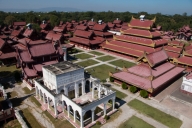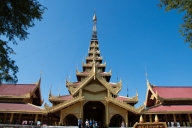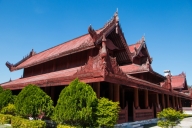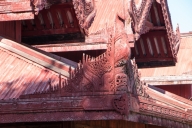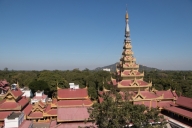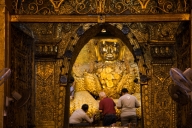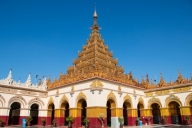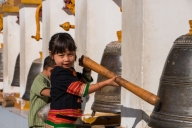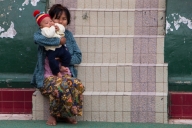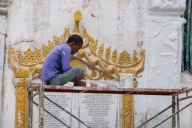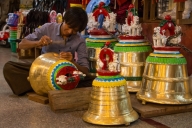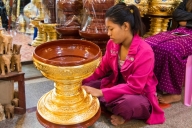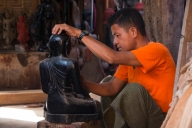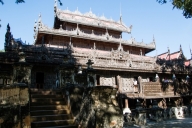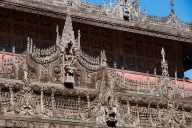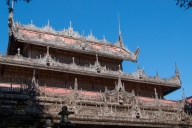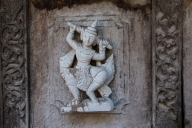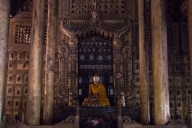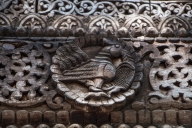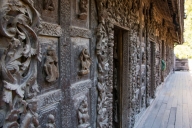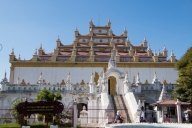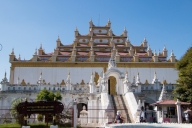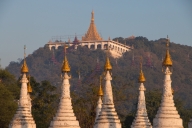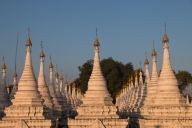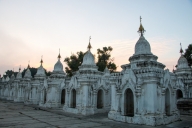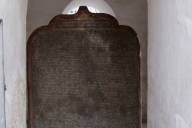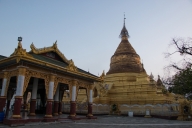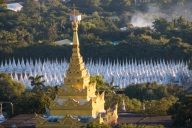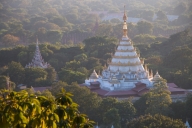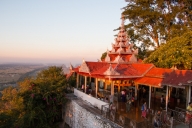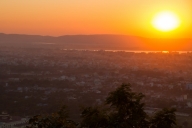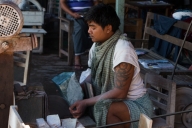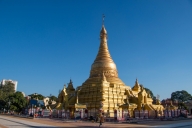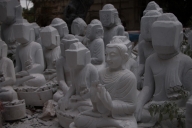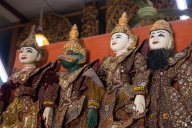Visited in December 2016
I didn’t fall in love with Mandalay at first sight. In fact, after the beauty and mystique of Bagan, my very first impression of this 19th century city was one of disappointment. It’s flat, dirty and noisy, most of the buildings are nondescript and its highlights are hidden in plain sight. Yet the city grew on me very quickly and finally won me over. Now I think back on it as a major highlight of my visit to Myanmar and hope to come back one day.
If you are planning to visit Mandalay – do it soon. For a city of over 1.2 million people, it has very narrow streets, but luckily relatively few cars, as most people get around on motorbikes. And that’s probably the only reason the city is not completely paralyzed by a collapsed transportation system for now. The motorbikes are relatively new. I’ve heard that a few years ago most of the traffic here was bicycles. And even now, this was the only place in the world, where I realized a car would spend too much time navigating traffic and opted for a motorbike taxi instead. As tourism and (hopefully) the population’s wealth grow, the traffic situation will likely deteriorate rapidly before it gets any better.
" slug="mandalay-myanmar-warning-sign" order_by="sortorder" order_direction="ASC" returns="included" maximum_entity_count="500"]I spent a day touring the city and another day touring the surrounding towns, which arguably are even more interesting than the city itself. This was not enough time. Ideally, it would be better to have at least three full days for the city and the surrounding areas.
Here is what I saw in Mandalay:
" slug="mandalay-palace" order_by="sortorder" order_direction="ASC" returns="included" maximum_entity_count="500"]- Mandalay Palace. This is a good place to start exploring the city, in part because of its central location, but also because it only gets better after this. It’s right in the middle of town and you can’t miss it thanks to the wide moat and high walls and watchtowers that surround it. Foreigners are only allowed to access the palace through the eastern gate, where you will buy a combination ticket for the so-called Mandalay Archeological Zone for 10,000 kyats and where you will have to leave your passport or other government-issued ID with the military guard to get in. In exchange you will get a lanyard with badge that will mark you as a foreigner. (As if most of us don’t stand out like a sore thumb already). Other than the main road to the palace and the palace grounds themselves, the rest of compound behind the palace walls are off-limits to foreigners. A word of warning – the original palace was destroyed in Allied bombing raids during World War II, so you’ll be looking at a Disneyfied 90s recreation, built with concrete and corrugated metal, where the original palace building was mostly teak. Be sure to climb the Nan Myin Watchtower for a good view of the entire complex. Also, don’t discard the ticket, as it is required for entry to several sites both in Mandalay proper, and in the surrounding towns, including the spectacular Shwenandaw Monastery. " slug="mahamuni-temple-in-mandalay" order_by="sortorder" order_direction="ASC" returns="included" maximum_entity_count="500"]
- Mahamuni Buddha Temple. After Shwedagon Pagoda in Yangon, this is the second most important Buddhist site in the country. Many tours of Mandalay’s suburbs actually stop at Mahamuni on the way out of town, so if you are pressed for time you might want to save your visit until your tour of Amarapura, Inwa and Sagaing. However, there is enough to see here to merit coming back twice. The temple complex is big enough and interesting enough that you can easily spend a couple of hours exploring here. The centerpiece of Mahamuni is a 4-meter Bronze seated Buddha statue, which was one of 5 cast in his lifetime, according to local tradition and “imbued with his essence” after Siddartha Gautama saw it and breathed upon it. Male devotees can approach the image and apply gold leaves to it. Thanks to their efforts the statue is now covered in gold. If you want to do this, be sure that you to dress appropriately – shorts are not allowed and unlike Shwedagon, I did not see longyis for sale at Mahamuni, although I didn’t look. Every early morning monks brush the teeth and wash the face of the Buddha image. This daily ceremony lasts about one hour and starts at 4 or 4.30 AM, so it would take a much earlier start of the day than I was capable of. " slug="mahamuni-artisanal-workshops" order_by="sortorder" order_direction="ASC" returns="included" maximum_entity_count="500"]As you exit Mahamuni through the passageways leading in the four cardinal directions, be on the lookout for the local artisans creating different religious and cultural objects and souvenirs. The care and labor that goes into the creation of each of these souvenirs is truly impressive. " slug="Shwenandaw-Monastery-teak-monastery-Mandalay" order_by="sortorder" order_direction="ASC" returns="included" maximum_entity_count="500"]
- Shwenandaw Kayung. This 19th century teak building was hands down my favorite site in the city and is arguably the finest surviving example of teak architecture. Originally part of the palace complex, it was moved to a new site after king Mindon died in its hall and his son Thibaw found this reminder of his father’s death too distressing to be in. The move saved this magnificent building from suffering the fate of the rest of the original Mandalay palace. It’s easy to spend a lot of time here, admiring the varied fine teak carvings on the doors, walls, pillars and roof of the building and you might need the extra time to try to catch it in between large groups of tourists. After you’re done, be sure to check out the impressive Atumashi Monastery next door for a totally different side of local architecture. " slug="kuthodaw-pagoda-mandalay-myanmar-burma" order_by="sortorder" order_direction="ASC" returns="included" maximum_entity_count="500"]
- Kuthodaw and Sandamuni Pagodas. Located at the foot of Mandalay Hill, this mid-19th century pagoda has beautiful golden stupa as its centerpiece, but is more famous for its 700-plus smaller whitewashed pagodas, each containing a carved alabaster slab with a page from the Tipitaka, a Buddhist canonical text. Together, this complex is known as “the world’s largest book”. Once the complex was completed, it took 2,400 monks six months to recite the text inscribed therein. The book’s “second volume” is the adjacent Sandamuni Pagoda with 1774 marble slabs inscribed with commentaries on the Tipitaka. A good idea is to come here at sunrise and enjoy the play of light on the white pagodas against the greenery of Mandalay Hill. " slug="mandalay-hill-myanmar" order_by="sortorder" order_direction="ASC" returns="included" maximum_entity_count="500"]
- Mandalay Hill. You can take a taxi to the top of Mandalay hill and it might be best to do so, if you are pressed for time, and want to make it to the top for the sunset, but the more scenic option is to take one of four stepped walkways. There is also an escalator/elevevator tower, but I only discovered it on the way down and the line looked intimidating. Be prepared for a 30 to 45 minute barefoot walk, but there are some cool views of the city along the way and some interesting temples. I walked both ways and to be honest, the sunset view was not as spectacular as Bagan’s, and, of course, the Sataungpyei Temple at the summit was extremely crowded. It still made for a good way to cap off my day in Mandalay. " slug="mandalay-jade-market-myanmar" order_by="sortorder" order_direction="ASC" returns="included" maximum_entity_count="500"]
- Jade Market. Much of the world’s jade is sourced in Myanmar and Mandalay’s jade market sees a lot of it. There is apparently a small entrance fee for foreign tourists, but I came here on a Sunday and there was no one to collect it. According to my driver, the market is much less busy on weekends, but it was still fairly active with jade buyers shining lights on offered pieces of jade to assess their quality, and noisy due to the work done by the cutters and polishers working to refine the rough jade stones. It was definitely worth stopping by to see it.
There are a few more places to see in Mandalay, like the Eindawaya Pagoda, with its beautiful guided stupa, and some of the workshops, where carvings, marionettes and Buddha statues are crafted, are a must see. The night market was also pretty interesting.
" slug="mandalay-workshops-myanmar" order_by="sortorder" order_direction="ASC" returns="included" maximum_entity_count="500"]I also had my best meal in Myanmar in a restaurant in Mandalay. The place is called Aye Myit Tar. It has no website, but you can see the reviews on this TripAdvisor page. My delicious Burmese meal cost less than $5 all in, and I could not finish it. Be sure to bring a healthy appetite and some friends, so you can sample different dishes and share.
Hotel options are plentiful. I stayed at a fairly basic hotel which was great for the price. I also stopped by the modern Link 78 Hotel, which seemed like it would have a good view from its top floor restaurant. The food was expensive and took forever, but I did get a tour of the rooms and it seemed like a great place to stay, otherwise.
Unfortunately, I ran out of time. My second last day in the area was spent touring the surrounding towns, so I didn’t get a chance to see the Gold Pounders’ district, where skilled laborers pound the metal into the thin leaves used to decorate the Buddha images seen all over Burma. I also tried to visit the second famous, but much less touristed teak monastery in the city called Shwe In Bin Kyang, but despite my guidebook saying that it was open until 10PM, there was a padlock on the gate when I showed up there an hour after sunset. My driver wanted to see if he could talk the monks into letting us in, but it was so dark in the courtyard, it was obvious that we would still see nothing. Finally, it would have been great to take a look at the city life on the banks of the Ayeryarwady river. I am not too concerned though, just looking forward to doing all these things on my next visit.




